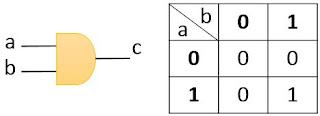We all know about D or Delay Flip-Flops. It is edge triggered device which transfer input (D) to output (Q) on its rising or falling of clock (clk). Truth table and timing diagram of D Flip-flop is
| D Flip Flop and Truth Table |
| D-Flip Flop Timing Diagram |
Above simulation timing diagram do not include the delay of D flip-flop. We can analyze this delay's behavior of D flip-flop by following two mux diagram.
| Two MUX diagram of D Flip Flop with Truth Table |
Let’s take delays of mux-1 and mux-2 are t1 and t2 respectively. When clk is ‘0’ then mux-1 take at least t1 time to update the value from 'D' to 'Qn' and when clk is ‘1’ then 'Qn' is remains same. During t1 time input 'D' must not change. This t1 time is called Setup Time (Ts). So the setup time is the time interval before clock where input ‘D’ must held stable.
Similarly for mux-2 when clk is ‘1’ then mux-2 takes at least t2 to update the value from 'Qn' to 'Qn+1' and when clk is ‘0’ then 'Qn+1' is remains same. During t2 time input 'Qn' must not change. This t2 time is called Hold Time (Th). So the hold time is the time interval after clock where input ‘Qn’ must held stable.
There is one more timing property which we should also need to understand with setup and hold i.e. 'clock to Q' delay. Time interval from clock input to data out from flop.
SETUP TIME ANALYSIS IN NETWORK For synchronous circuit with in one clock cycle (Tclk) data should transfer from one flop to next flop. This transfer time depends
HOLD TIME ANALYSIS IN NETWORK
Similarly for mux-2 when clk is ‘1’ then mux-2 takes at least t2 to update the value from 'Qn' to 'Qn+1' and when clk is ‘0’ then 'Qn+1' is remains same. During t2 time input 'Qn' must not change. This t2 time is called Hold Time (Th). So the hold time is the time interval after clock where input ‘Qn’ must held stable.
There is one more timing property which we should also need to understand with setup and hold i.e. 'clock to Q' delay. Time interval from clock input to data out from flop.
 |
| Timing Diagram of two mux D flip-flop |
Summery : Important timing parameter of Flip-Flop are.
Setup Time (Ts) : Till the time input ‘D’ remains stable before the clock edge.
Hold Time (Th) : Till the time input ‘D’ remains stable after the clock edge.
Clock to Output Time (Tc2q) : Time between input clock edge to the output ‘Q’.SETUP TIME ANALYSIS IN NETWORK For synchronous circuit with in one clock cycle (Tclk) data should transfer from one flop to next flop. This transfer time depends
- clock to Q delay of launch flop (Tc2q)
- propagation delay of combo logic (Tpd)
- setup delay of capture flop (Ts).
 |
| Setup Time Analysis |
Let’s introduce the delay in timing equation one by one. From above diagram we can say that for successful transfer of ‘D’ the propagation delay of the combo logic should be less than one clock period.
Tpd < Tclk
Tpdis dynamic delay which depends on combo logic delay and Tc2qand Tsis static delay which are fixed for certain flop. The clock to Q delay of launch flop is the additional delay in path, so combined of Tc2qwith Tpd should be less than one clock period Tclk.
Tpd + Tc2q < Tclk
It is also compulsory that data should arrive at capture flop setup time (Ts) before the clock edge.
Tpd + Tc2q < Tclk - Ts
Till this point we have not include clock uncertainty and clock buffers delay in network. Now from above equation data arrival time is (Tpd + Tc2q) and data required time is (Tclk- Ts).
The difference of data required time to data arrival time is called the SLACK.
SLACK = (Tclk - Ts) - (Tpd + Tc2q)
SLACK can be positive or negative, positive slack means data arrive at capture flop is before the clock edge and negative slack means data arrive at capture flop is after the clock edge also called setup violation.
Setup violation accrue if clock arrives early than data. To avoid setup violation 'maximum data delay' should be smaller than 'minimum clock delay'.
HOLD TIME ANALYSIS IN NETWORK
In a synchronous circuit transfer time should be greater than hold time of the capture flop. Because data should not change too fast so that it violate hold time of capture flop. This transfer time depends on
- clock to Q delay of launch flop (Tc2q)
- propagation delay of combo logic (Tpd)
 |
| Hold Time Analysis |
For proper communication delay should be greater than hold time of capture flop. So
Tc2q+ Tpd > Th
Uncertainty in clock path do not play much role because we use same clock edge for hold time analysis. From above equation data arrival time (Tc2q+ Tpd) should be greater than data require time (Th).
The difference of data arrival time to data required time is called the HOLD SLACK.
SLACK = (Tc2q+ Tpd) - (Th)
SLACK can be positive or negative, positive slack means there is enough delay for capture flop to hold previous data and negative slack means there is less delay and previous data changes before it successfully captured by capture flop this also called hold violation at capture flop.
Hold violation accrue if data arrives early than clock. To avoid hold violation 'maximum clock delay' should be smaller than 'minimum data delay'.
Now also review other timing parameter like clock tree delay and uncertainty on setup and hold delay in flop network in next part.



